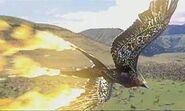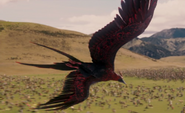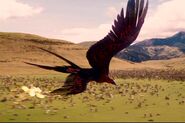- "I used to watch them as a kid. My granny told me about 'em. Some cold nights you see them dancin' in the sky over the Hub, burnin' green and gold...""Oh, you mean the aurora coriolis," said Oats, trying to make his voice sound matter of fact. "But actually that's caused by magic particles hitting the-" "Dunno what it's caused by," said Granny sharply, "but what it is is the phoenix dancin'."
- "I was never surprised that they did not have a phoenix on display. There is only one phoenix at a time, of course, and while the Natural History Museum was filled with dead things, the phoenix is always alive."
- ― Neil Gaiman, Unnatural Creatures
A Phoenix is a powerful, giant, supernatural, bird that has been a lasting mythological icon for millennia, and has existed in many cultures. Despite the varieties of societies and times it appeared in, the Phoenix was consistently described as a bird with brightly colored plumage and the size of an eagle, or ostrich. After a long life, dies in a fire of its own making only to rise again from its own ashes. From religious and naturalistic symbolism in ancient Egypt, to a secular symbol for armies, communities, and even societies, as well as an often-used literary symbol, the representation of death and rebirth by this mythical creature seems to resonate with the aspirations of humanity.
Origins[]
The Phoenix is a creature with origins in Greek and Roman mythology, legend and folklore. It has since gained connections to Medieval European mythology, legend and folklore. And within the course of these various accounts, the Phoenix is one of the most well-known and best-recognized symbols for immortality and nature's cycle of long life, death and rebirth.
Likewise, it is attributed a divine connection with the sun, since it possesses a great longevity, only to die and return (just as the sun rises, sets and rises again). Many accounts even acquaint it with qualities fitting the various sun deities of ancient mythology, legend and folklore (including the Greek Helios and the Egyptian Ra).
Appearance[]
Different descriptions are given, for the specific breed to which the Phoenix might be most closely related. In some accounts, the creature is said to resemble a rooster or a peacock. Though, most accounts describe the Phoenix as a creature resembling an eagle.
Likewise, some claim that the creature is the size of whatever creature it resembles (be it a rooster, peacock, eagle or other), while others state that it is larger than an eagle, and even a few going so far as to say that it is larger than an ostrich.
Characteristics[]
Phoenix, a mythical, sacred fire-bird that symbolizes rebirth, immortality, and renewal in the mythologies of the Arabian, Persian, Greek, Roman, Egyptian, Chinese, Turkish, Indian and Phoenician/Canaanite people.
The Phoenix is described as birds with colorful plumage and a tail of gold and scarlet, yet according to some legends, other colors decorate this beautiful bird. It is also said its size can be as small as an eagle, to as large as an ostrich, or house. They have a 500-1,461-year life-cycle. Near the end of its life, a Phoenix will build itself a nest of twigs, herbs, and/or whole trees that it then ignites; both nest and bird burn until merely ashes are left, from which a new, young phoenix or phoenix egg arises, reborn to live again.
Powers & Abilities[]
- "Fascinating creatures, phoenixes. They can carry immensely heavy loads. Their tears have healing powers."
- -Dumbledore
Phoenix Bird Physiology - Phoenixes are amongst the strongest and most durable of supernatural creatures. They are quite powerful and almost impossible to kill.
- Incineration Touch - In human form, a Phoenix can incinerate anyone/anything with a single touch. Their ability is so strong, they can reduce a whole man to ashes in seconds. This ability is similar to an angel's smiting.
- Fire Mimicry -
- Superhuman Speed - A Phoenix is the fastest creature to exist. A Phoenix can move way above the speed of light.
- Pyrokinesis - Has control over all fire.
- Hell-Fire/Holy-Fire - Can summon and use hellfire/holy-fire as a weapon and a defense
- Immortality - Phoenixes are immortal, they will not permanently die from aging or natural causes. That said, most do still age (at least when in their true form) and it's this aging that often leads to their fiery, albeit temporary, death, and inevitable rebirth.
- Invulnerability - Phoenixes are nigh-invulnerable. They can take repeated shots in the chest and not even react, and can even be reborn after absorbing a killing curse. However, significant force, such as being hanged can knock them out for a while.
- Superhuman Strength - Phoenixes are incredibly strong; capable of effortlessly lifting a great weight with their tails, such as being able to fly up a long distance with a handful of people holding on to its tail. Even in human form, they are strong enough to break out of coffins, even after it has been nailed down and buried.
- Healing Tears -
- Healing Factor - The most startling of the Phoenix's abilities is its ability to regenerate itself. They can heal/regenerate from any and all non-fatal injuries.
- Nigh-Omnipotence (in some cases)
- Pyroportation - Phoenixes can disappear and reappear at will in bursts of flames and take whoever is holding them along.
- Chronokinesis - Phoenixes can control time.
- Shapeshifting - Phoenixes can take a human form to conceal their true form, which is that of a giant bird.
- Self-Resurrection -
- Matter Transmutation -
- Photokinesis -
Types of Phoenix[]
Weaknesses[]
- Iron - Phoenix's are Immortal and Powerful they're still vulnerable to iron like many other supernatural creatures. When a Phoenix is touch with iron, they burn. It is possible to create a weapon from iron to kill the Phoenix. Dowsing a Phoenix will kill it, but it will be reborn unless you destroy the ashes.
- Magic - Phoenix are susceptible to the powers of magic.
- May take a while to resurrect
Gallery[]
Related sites[]
- Mystic Phoenix from Beyblade Fanon Wikia
- Phoenix Tribe from LEGO Legends of Chima Wikia
- Fire Tribes from Legends of Chima Wikia 2
- Phoenix from Narnia Wikia
- Phoenix from Beast Wars Transformers Wikia
- Phoenix from Harry Potter Wikia
- Phoenix from Rosario + Vampire Wikia
- Phoenix Physiology from Powerlisting Wikia
- Phoenix from Marvel Wikia
- Phoenix from DC Wikia
- Phoenix from God of War Wikia
- Phoenix from The Demonic Paradise Wikia
- Phoenix from Gods & Demons Wikia
- Phoenix from Mythology Wikia
- True Phoenix from Martial World Wikia
- Phoenix from Against the Gods Wikia
- Phoenix from The Liberators Wikia
- Phoenix from TeenWolf Next Generations Wikia
- Phoenix from BloodRayne & Mia, the Vampire Slayer Wikia
- Phoenix from Haypi Monster Wikia
- Phoenix from Soul Sacrifice Wikia
- Egyptian God Phoenix from Yugipedia
- Phoenix from OSRS Wikia
- Phoenix from Crash Fever Wikia
- Legend of the Phoenix Wikia
- Phoenix from Harry Potter Wiki
- Phoenix from Supernatural Wiki
- Phoenix from Roblox Wikia
- Phoenix from Dubbing Wikia
- Phoenix from Magistream Wikia
- Phoenix from Merlin Wikia
- Blue Phoenix Wikia
- Phoenix from Inazuma Eleven Wikia
- The Phoenix of Life from FC/OC VS Battles Wikia
- Phoenix from Endless frontier Wikia
- Phoenix from Kingdom Rush Wikia
- Phoenix from Spore Wikia
- Phoenix from The Masked Singer Wikia
- Phoenix from Osamu Tezuka Wikia
- Phoenix God from Soul Land Wikia
- Phoenix from Monster Wikia
- Phoenix from Feather Family Roblox Wikia
- Phoenix from The Parody Wikia
- Phoenix from VS Battles Wikia
- Phoenix from Dragon Quest Wikia
- Phoenix from Blox Fruits Wikia
- Phoenix from Castle Crush Wikia
- Phoenix from Forgotten Realms Wikia
- Phoenix from Huntik Wikia
- Phoenix from Videogame Wikia
- Phoenixverse Wikia
- Phoenix from PathFinder Wiki
- Magiphoenix from Power Rangers Wikia
- Phoenix from Supernatural Wikia
- Immortal Phoenix / Egyptian God Phoenix from Yu-Gi-Oh! Wikia
- Phoenix from Might & Magic Wikia
- Phoenix from Princess Resurrection Wikia
- Phoenix from Spiderwick Chronicles Wikia
- Phoenix from Ultimate Pop Culture Wikia
- Phoenix from Youtube


